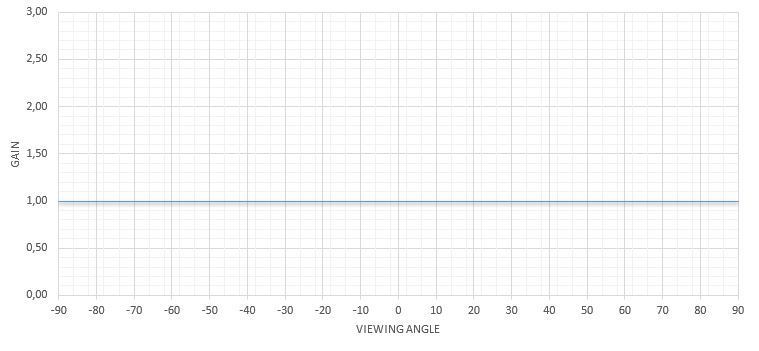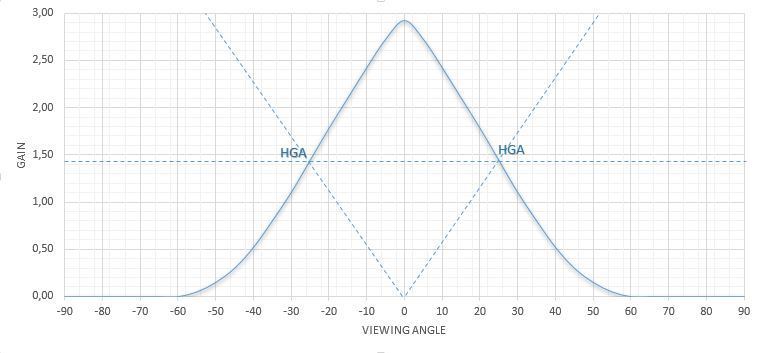Optical gain graphs: What they mean and how to read them
July 10, 2018When deciding which projection screen is best for your project, you will inevitably encounter a gain graph. An optical gain graph allows you to understand a surface’s reflective and light diffusion properties.
First, let’s briefly define what “gain” means. “Gain” is an industry term that is defined as the measure of light reflected by a screen when compared to a perfect matte white surface, also known as a Lambertian surface . It is measured by using a luminance meter.
By definition, matte white, or “unity gain,” is given a measurement of 1.0. Therefore, a screen with a gain of 1.0 will reflect the same amount of light that a perfect matte white surface reflects. A matte white/unity gain surface reflects all colors evenly and in all directions. The gain table below represents a unity gain surface. The vertical axis shows the gain reading, while the horizontal axis represents the viewing angle.
Peak gain is measured from the spot where the screen is at its brightest. This point is found directly in front of the center of the screen where the projected light hits perpendicular to the surface. In the table above, the viewing angle at 0 marks this point. A viewer seated at any angle in front of this surface will perceive the same amount of reflected light, which is shown here by the completely flat horizontal gain line.
A screen having a peak gain reading of 1.5 reflects 50% more light directly in front of the light’s centerline path when compared to a 1.0 gain screen. A 2.0 gain screen reflects 100% more light and so on. Inversely, a screen with a peak gain of 0.5 reflects 50% less light than a 1.0 gain screen, etc.
When peak gain increases, however, brightness tends to diminish as the viewing angle widens. Why is this? Well, surfaces that reflect more light intrinsically create a “hot spot.” Brightness is concentrated where the light source hits, and then it drops off as light is diffused towards the edges. This applies to high gain projection screens — screens on which a special coating is applied to increase the material’s ability to reflect light. See the gain curve below, which represents a high gain screen. Peak gain is very high, which means that a viewer seated directly in front of the center of the screen (i.e., the viewing angle at 0 in the table), sees a very bright picture. However, a viewer seated at a 25-degree angle from the projected light path only perceives half that amount of brightness. The angle at which half the brightness is reflected is called the half gain angle, or HGA. The half gain angle is often used to compare screens because it is a good reference point when comparing the light distribution qualities of different materials. It also sets the limit of the viewing cone, the maximum angle at which a display can be viewed with acceptable visual performance.
High gain screens do not distribute light as evenly as their low gain counterparts, but they serve their purpose when brightness needs a boost. For example, they work well when paired with low output projectors. They also compensate for the loss of brightness that occurs when light moves through polarization filters on projectors, which is required for polarized 3D. Since projector lamps are expensive, decreasing light output requirements by using a high gain projection surface also reduces operation costs.
Low reflectance surfaces, on the other hand, can be used with high output projectors. They are also effective when cross-reflections from other light sources are a problem, and they are a must when an audience is seated in a wide space. To know what gain is suitable for your environment, you must consider various factors: the amount of ambient light; your projector’s output, throw, and position; the size of your screen; and the placement of your audience.
Once you understand how to read a gain table, you will know how reflective a surface is and how evenly it reflects light. By knowing the half gain angle, you can set the outer limits of the ideal viewing cone. As a result, you will identify the angle at which your audience should be seated. If the curve is not too steep beyond the HGA point, the viewing cone may possibly extend a little further. Understanding a gain table is essential because it tells you how your surface will reflect light when it is subjected to projection.



